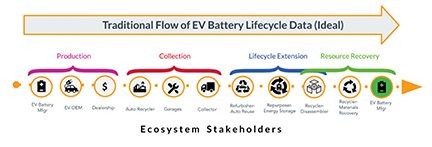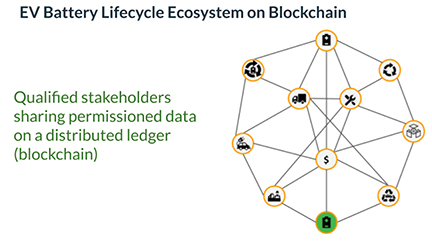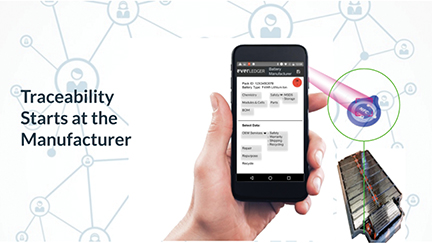Advanced Technologies for Product Lifecycle Management
By Lauren Roman, Everledger
With a variety of working blockchain platforms servicing multiple industries across the globe, Everledger is a standout in the blockchain space, leveraging a symphony of advanced technologies to drive circular economies for materials and products.
Advanced Technologies for Product Lifecycle Management
By helping to close the loop on product lifecycles, reverse logistics plays an essential role in supporting a circular economy for products and materials. In an ideal circular economy, waste is designed out of a product at the onset. But with trillions of items already in circulation without such a benefit at birth, it is the role of the reverse logistics industry to help brand owners, retailers and many others to get out-of-use products back into reuse or to responsible recycling operations. Advanced technologies can add efficiencies and reduce risks and costs of product lifecycle management and benefit all participants in the value chain.
A Symphony of Technologies
To effectively manage an asset, product or material, we need to know where it is, who has it and what condition it is in. The best means of accomplishing this is to first ‘IOT-enable’ the asset or give it a ‘digital identity’ by connecting it to the internet. Although a plethora of advanced asset identification technologies exist, from 3D photography to digital DNA and beyond, for product life- cycle management in general we can focus on common auto-ID solutions such as QR codes and near field communication (NFC). Later in this article we will also address the importance of knowing how the product was produced, it’s origins and the actors in its corresponding lifecycle.
Most RLA members are quite familiar with QR codes, with RLA having developed its own specialty QR code named the 12N Code. A standard QR (quick response) code is a type of barcode that contains a matrix of dots. It can be scanned with a cellphone camera and open a URL in a web browser, providing the user access to any type of information. RLA’s 12N code looks quite similar but can store much more data.
An NFC tag is another type of auto ID that can be applied to an asset and scanned into a URL or other database with a cellphone. NFC tags generally provide information faster and easier than QR codes and are more secure.

Sensors that determine temperature, location, humidity, orientation, pressure or vibration connected to the Cloud through conduits such as GPRS, 4G/5G, RFID, Low Power Bluetooth or other beacon technology further support the connected world of objects and the myriad of value propositions that come with that connectivity. Although these technologies provide the immediate user or the producer of the product with information, they don’t necessarily support optimization of the benefits of distributed participation in the access and addition of data about the object throughout its lifecycle in a qualified and trusted environment. Enter blockchain. Blockchain, as a platform to an IOT connected supply-chain, assists in connecting permissioned stakeholders in the lifecycle of a product, supporting trusted data collection and sharing in real time, thereby delivering transparency and trust.
Blockchain: Unprecedented efficiency and transparency
Everledger is a five-year old technology company leveraging these and other technologies for a variety of industries, generally focusing on high risk, high opportunity and high value assets. Digitally streamlining compliance processes helps producers and others demonstrate the lifetime story of an asset with greater efficiency and accuracy.
The Everledger platform enables buyers and sellers to trade with confidence. The blockchain platform provides a secure record of an asset’s origin, journey and condition by surfacing the asset’s lifetime story.
Once in the consumer’s hands, the stream of [product] data ends; along with opportunities to retain contact with that consumer to ensure satisfaction, support repairs, encourage recycling and incentivize a new purchase at end of use.
Everledger’s solutions include tracking diamonds from the mine to prevent ‘blood diamonds’, uniquely identifying and tracking fine art and high-end liquors, wines and luxury goods supporting the prevention of substitution and counterfeiting fraud. Another provides the insurance industry with enhanced transparency to minimize fraud, mitigate risks, automate claims settlement and much more. Even low value but high ‘opportunity’ assets such as plastics and tires can be tracked and managed on a blockchain to support effective corporate sustainability reporting and responsible recovery.
A good demonstration of how blockchain can work is with a high risk, high opportunity asset such as lithium-ion batteries that are not only dangerous to handle but also have a supply chain at risk due to extensive reliance on small and artisanal mines that can involve child and conflict labor along with severe environmental issues. Brand owners want to ensure a sustainable supply of critical metals and minerals by keeping track of batteries to ensure full recovery of resources for reuse in new batteries.
The diagram below shows key stakeholders in the lifecycle of an electric vehicle battery (EVB) in a traditional data flow scenario:

In this traditional, linear way of communicating information; without extensive contract terms, oversight and enforcement the manufacturer has little or no visibility on what is happening with a product after it is sold. Once in the consumer’s hands, the stream of data ends; along with opportunities to retain contact with that consumer to ensure satisfaction, support repairs, encourage recycling and incentivize a new purchase at end of use. Even more concerning, the manufacturer can only hope that repairs are made with authentic parts and conducted safely and properly and that when the product is no longer of use it is responsibly recycled at an authorized recycling location.
When these stakeholders are connected on a distributed ledger, or blockchain, information about the asset can be viewed by permissioned stakeholders across the lifecycle in real time.

This system supports transparency by allowing users to use, store and search asset information on demand and make it available to customers and end consumers. By making asset information easily accessible and verifiable, blockchain allows trust to take root and spread throughout industries. By creating a unique identity, or digital twin of an asset, users can trace its journey on a secure, unalterable and private platform. Sustainability and compliance claims are supported with actual shared evidence of audits and certifications. Ethical sourcing and environmental claims can be demonstrated with a secure, unalterable record of an asset’s lifetime journey.
Benefits to Supply Chain and Value Chain Stakeholders
To demonstrate how stakeholders in the lifecycle can benefit, let’s return to the example of the EVB lifecycle.
EVB Manufacturer - Supply chain transparency ensures sustainably sourced materials. Lifecycle traceability ensures resources are recovered at end of life to secure long term material supplies.
E-Vehicle OEM - Sharing data about the battery with lifecycle stakeholders supports safe and efficient repair, refurbishment, repurposing and recycling, eliminating the need for these value chain partners to waste time searching for critical information that is now readily available. Ownership can be transferred on the blockchain when repurposers alter the batteries to create new energy storage batteries, reliving the OEM of liability during second life. Receipt and processing at an authorized recycler can be validated.
Auto recycler - Information on warranty status can be accessed as well as information on battery chemistry and related safe handling instructions such as removal of the battery from the car and packing for shipment to recycling. If the OEM provides shipping and recycling instructions they can see that the battery has, in fact, been shipped to an authorized recycler.
Garages - When a vehicle arrives at a garage, even if it is not in the garage’s system a simple tap of the NFC tag will provide information to speed assessment of the battery. In addition, as a permissioned stakeholder, the garage can upload repair data onto the platform for downstream stakeholders to access.
Refurbishers and Repurposers - Knowing the history of the battery is critical to refurbishers and repurposers since many accidents will render the battery unsafe for continued use/reuse. When batteries are safe for reuse, having ready access to data that is otherwise time consuming or not at all available keeps their costs in check.
Recyclers - The connected ecosystem enables authorized recyclers to validate that the battery has been received for processing. Proof of processing, such as a video, can be shared along with downstream shipping documents. Recycler certifications and supporting documentation can also be lodged.

Getting Started - Be Cautious and Prepared
If you’ve come this far then perhaps blockchain can address some of the challenges in your supply and value chains. Be wary when searching for blockchain solutions providers since there are many more out there claiming to have working solutions than actually do. A world with such solutions is exciting and shows huge prospect as does the relevance of blockchain to the future internet, however the technology presents all sorts of challenges and paradigm changes to what is generally recognized as “normal” IT infrastructure and processes. You don’t want to pay to be guinea pig to large or small organizations with little experience and learning in the space. Ask for evidence of working solutions and client references.
Be sure you and/or your team understand your business processes intimately and can share challenges with solutions providers. If you contact solutions providers and vaguely ask them how they can help you, you will neither get a good response nor will they likely be able identify the best approaches for you.
Your service provider should not just be a good solutions developer, but also have expertise related to your industry and issues. Understanding the nuances and challenges specific to your industry will deliver solutions that solve problems far beyond basic business needs.
 Lauren Roman
Lauren RomanLauren has had an extensive career in electronics lifecycle management with early work in development and launch of the Electronic Product Environmental Assessment Tool (EPEAT) and both the R2 and e-Stewards standards for responsible electronics recycling. Now leading Everledger’s work in the metals and minerals sector, Lauren serves on the Global Battery Alliance (program of the World Economic Forum) Steering Committee working to create a global circular economy platform for electric vehicle and other lithium ion batteries. She chairs the Alliance for Advanced Transportation Batteries (NAATBatt International) Exchange & Tracking Committee and is a leading participant in the Responsible Battery Working Group of the Supplier’s Partnership for the Environment. Recently Lauren was named to lead the Battery Cluster for the International Federation of Automotive Engineering Societies (FISITA).
Reach Lauren at Lauren@Everledger.io